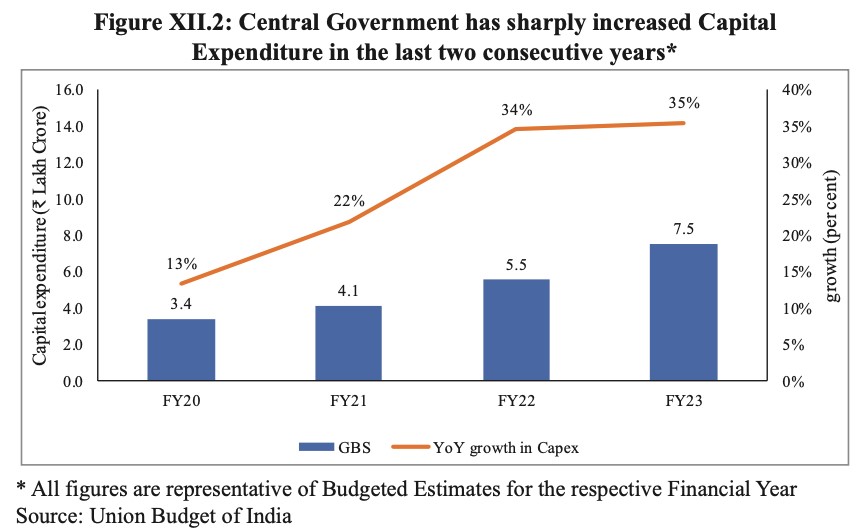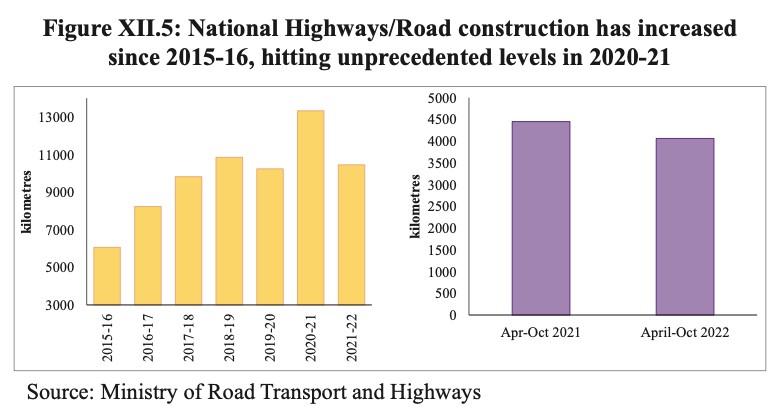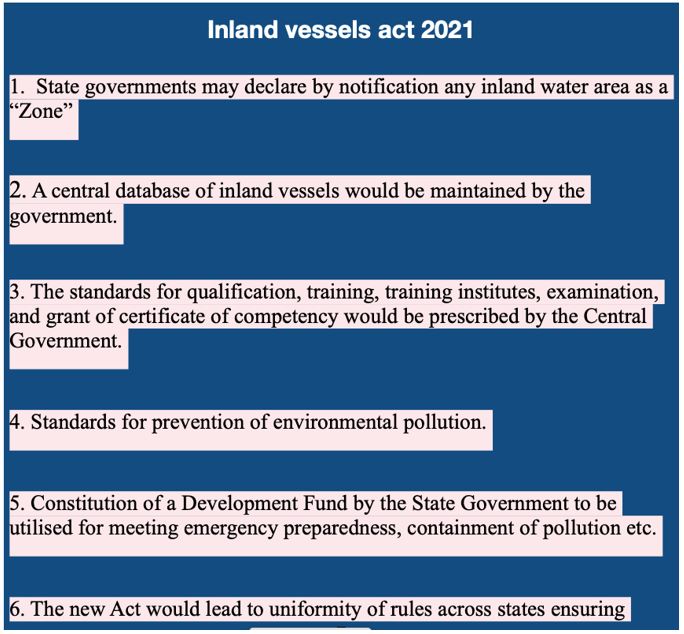CHAPTER 12 – PHYSICAL AND DIGITAL INFRASTRUCTURE: LIFTING POTENTIAL GROWTH
Introduction
- To broaden the country’s socio-economic development, the Government has used social overhead capital to enhance development in the country’s remote areas via budgetary allocations, subsidies and effective programme delivery.
- In an integrated approach to developing infrastructure, the Government put forth the National Infrastructure Pipeline with a projected investment of 111 Lakh Crore FY20-25.
- Infrastructure development funding comes from various sources such as Government, private, and multilateral.
- Other structural and financial reforms by the Government, such as InvITs, REITs, creation of dedicated financial institutions (NaBFID), and viability gap funding, are crucial for the extension of infrastructure facilities.
- To increase private participation in infrastructure development government has taken initiatives such as public-private partnership (PPP Model), National Infrastructure Pipeline (NIP), and National Monetisation Pipeline (NMP).
- To increase efficiency and cost-effectiveness government has launched PM Gati Shakti and National Logistics Policy (NLP).
- The Government mainly focuses on multimodal transport infrastructure through roads, railways, airports, ports and waterways.
- Digital infrastructure also has gained a significant pace in the last decade. For example, only 17% population had a bank account in 2009, compared to 87% in 2021.
- Service delivery has become more efficient than ever with Digital innovations. For example, the CoWIN portal, Digilocker, Open network for digital commerce (ONDC) etc.
Government’s vision and approaches to infrastructure development:
- The outlay for capital expenditure increased by 35.4% in FY23 compared to last year.

- The increase in capital expenditure has helped to revive economic growth post-pandemic. However, this could also crowd in private investment.
- The National Logistics Policy (NLP) seeks to address the gaps in digital infrastructure and skills in the logistics workforce.
- PM Gati Shakti endorses a multimodal approach. It is designed to fill the gaps in physical infrastructure and integrate existing infrastructure facilities.
- Taking a step forward, India is now focusing on advanced infrastructure. Advanced infrastructure focuses on energy efficiency, proposes the idea of a circular economy and transitions towards low-carbon development.
Public Private Partnerships (PPP):
- Private investment in the infrastructure sector mainly comes in the form of PPPs. PPP helps to address infrastructure gaps and improve deficiencies in service delivery.
- Several PPP models, such as Built-Operate-Transfer (BOT), Toll-Operate-Transfer (TOT), and Hybrid Annuity Model (HAM), have been implemented in India.
- To provide finances for economically unviable but socially/ economically desirable projects, Government launched Viability Gap Funding (VGF) scheme in 2006. Social sector projects in VGF include wastewater treatment, solid waste management, urban planning etc.
National Infrastructure Pipeline (NIP):
- The Government has launched NIP with a forward-looking approach and a projected infrastructure investment of around 111 Lakh Crore during FY20-25.
- The NIP includes both greenfield and brownfield projects. The transportation sector dominates the NIP investments, followed by energy, water & sanitation.
- NIP also hosts Invest India Grid (IIG) which acts as a platform for collaboration for various states and ministries. This centralised portal helps in tracking developments in social-economic infrastructure projects at a single location.
National Monetisation Pipeline (NMP):
- NMP is based on the principle of ‘asset creation through monetisation’, which seeks to attract private investment for new infrastructure projects.
- The aggregate monetisation potential of NMP has been estimated at around 6 Lakh Crore for FY20-25.
- Funds raised through NMP have mainly been used in roads, power, coal and mining sectors.
National Logistics Policy (NLP):
- Logistics cost in India is one of the highest in the world. It is around 14–18% compared to 8% in developed economies.
- Some significant hurdles in the Indian logistic system are cumbersome clearance processes, old-age infrastructure, higher operational costs, and lack of technology adoption, among others. These hurdles are also mentioned in Logistics Performance Index (LPI) published by World Bank.
- Considering this Government has launched the UDAN scheme, Bharatmala, Sagarmala, ParvatMala, e-Sanchit portal, Single Window Interface for Trade (SWIFT), Turant Customs and others.

- NLP seeks to integrate above mentioned programmes and provide an interdisciplinary, cross-sectoral regulatory framework to the Indian logistic sector.
- NLP seeks to achieve this target through Technology adoption, skill training of the logistic workforce, streamlining logistic processes and a non-complicated regulatory regime.
- The Government has also launched LEADS Index on the lines of the Logistics Performance Index. This index seeks to gauge the logistic ecosystem in Indian states.

PM Gati-Shakti:
- For holistic planning of the multimodal transport ecosystem government has launched the PM Gati Shakti programme with a transformative approach.
- PM Gati Shakti will act as an umbrella platform for all infrastructure projects of various ministries/states. It will serve as a single point of management, improving the collaboration and efficiency of implementing these projects.
- Project pertaining to seven engines of the economy under NIP (roads, railways, airports, ports, mass transport, waterways and logistic infrastructure) will be aligned with PM Gati Shakti.
- The programme emphasises integrated planning and synchronised implementation across various ministries/departments with technology adoption.
Developments in Physical Infrastructure Sector:
- Road transport:
- Approximately 10,500 km of roads were created in FY22.
- To monetise public sector assets, NHAI launched InvIT in FY22 to attract foreign and domestic investment in the road sector.

- Railways:
-
- With over 68000 km of routes, Indian Railways is the fourth largest Rail network in the world.
- As one of the most significant electricity users, Indian Railways has announced its target to achieve net zero carbon emissions by 2030.

- Civil Aviation:
-
- The civil aviation sector in India has great potential because of the rising middle class, growth in population and tourism, higher disposable incomes, favourable demographics and growing civil penetration in smaller cities.
- This is further supported by the programmes such as UDAN and International UDAN. Under these schemes, Government has approved a budget of 4500 Cr. for the revival of existing airports/airstrips. The scheme focuses on connectivity between tier 2 and tier 3 cities.
- The Government has also accorded in-principle approval for 21 new greenfield airports.
- Ports:
-
- Around 90% of India’s international trade by volume and about 79% by value are carried through ports.
- The cumulative capacity of India’s major ports is 1534 Million Tonnes per annum (MTPA).
- To expand port capacity and enhance efficiency, the Government focuses on improved port governance, addressing low-capacity utilisation, modernising berths and creating new channels for port connectivity.
- Reduction of Turn Around Time (TAT) is the highest priority for improving port efficiency. To reduce TAT Government is utilising digitalised processes such as e-Invoice, e-Payment and electronic delivery order (e-DO).
- RFID technology is being extensively used at ports to enable the seamless movement of vessels.
- Inland water transport:
-
- Due to the large endowments of rivers, canals and other waterways, India possesses great potential regarding inland water transport.
- The total navigable length of inland waterways in India is approximately 15,000 km. West Bengal has the highest navigable length of waterways, followed by Assam and Kerala.
- As per the National Waterways Act 2016, 106 new waterways have been declared National Waterways.
- The Inland Vessels Bill 2021 seeks to utilise the potential of a multimodal transport ecosystem and promote ease of doing business.
- Electricity:

- The total installed power capacity was 2 GW in 2022. As a result, the electricity sector witnessed 4.7% YoY growth.

- Thermal electricity constitutes the largest share (59.9%) of total installed power capacity, followed by renewable energy sources (27.5%).
- In line with its global commitments, India’s Energy sector is gradually transitioning from conventional to non-conventional energy sources.
- India has set a target of achieving 50% cumulative installed power capacity through non-fossil fuel sources by 2030.
- The Government of India is implementing PM KUSUM, which aims to provide energy and water security, remove diesel power pumps in the farm sector and generate additional income for farmers by producing solar power.
Developments in Digital Infrastructure:
- Telecommunication:
- Telecommunication services have penetrated the country’s remotest areas in the last decade.
- The total telephone subscriber base in India is 117 crore.
- The overall teledensity in India is 7%.
- Regional disparity ranges from 4% in Bihar to 270% in Delhi. States like Himachal Pradesh, Kerala, Punjab, Maharashtra, and Karnataka have one of the highest teledensity in the country.
- There also exists rural–urban disparity in the penetration of teleservices. To bridge this gap government has launched an umbrella scheme called Digital India. BharatNet Project scheme, Telcom Development Plan, and Aspirational Districts Scheme are also helpful in reducing this disparity.
- With a particular focus on the north-eastern region, the Government is implementing Comprehensive Telecom Development Plan (CTDP).
- Considering the island territories’ strategic and governance importance, Government is apt to proliferate telecom services to Andaman and Nicobar through underwater OFC.
- The launch of 5G services can impact consumers through higher data transfer speeds and lower latency.
- This holistic development of the telecommunication sector in India will trigger significant transformation across various sectors such as agriculture, tourism, health and education.
Digital Governance Initiatives:
- With the emergence of digital public infrastructure, digital literacy, innovation, and entrepreneurship – Service delivery has become much more efficient and effective.
- Which broadening of Aadhaar, and DBT, it is easier to implement schemes targeted for a particular sector and reduce leakages.
- However, a lack of knowledge about the existing schemes is a significant hurdle in the accessibility of these schemes. Understanding this Government has launched the ‘MyScheme’ portal.
- ‘My Scheme‘ portal acts as a Single national platform for information dissemination and launching any government scheme.
- The Government is also emphasising the domain of Artificial Intelligence (AI). India’s widespread cultural and linguistic diversity makes AI one of the most important tools for overcoming Communication barriers. For example, ‘Bhashini’, the National Language Translation mission, is an AI-based model for text-to-speech conversion.
- The introduction of a Unified Payment Interface (UPI) seeks to revolutionise the payment landscape through universal operability, a single payment address and a low-cost mobile-based payment system.

- Under “Mission DroneShakti”, India is gearing up for the upcoming drone industry.
Conclusion:
- In the new normal, where the economy is recovering from the setback of the pandemic and existing geo-political conflicts, investment in the infrastructure sector can be crucial for sustaining economic growth.
- With the targeted increase in capital expenditure by the Government through NIP, PM Gati Shakti, NMP provides a forward-looking roadmap for infrastructure development in the country.
- Innovation and adoption of new technologies in power, road, railway, and aviation are indispensable for the advancement of the infrastructure sector in India.




